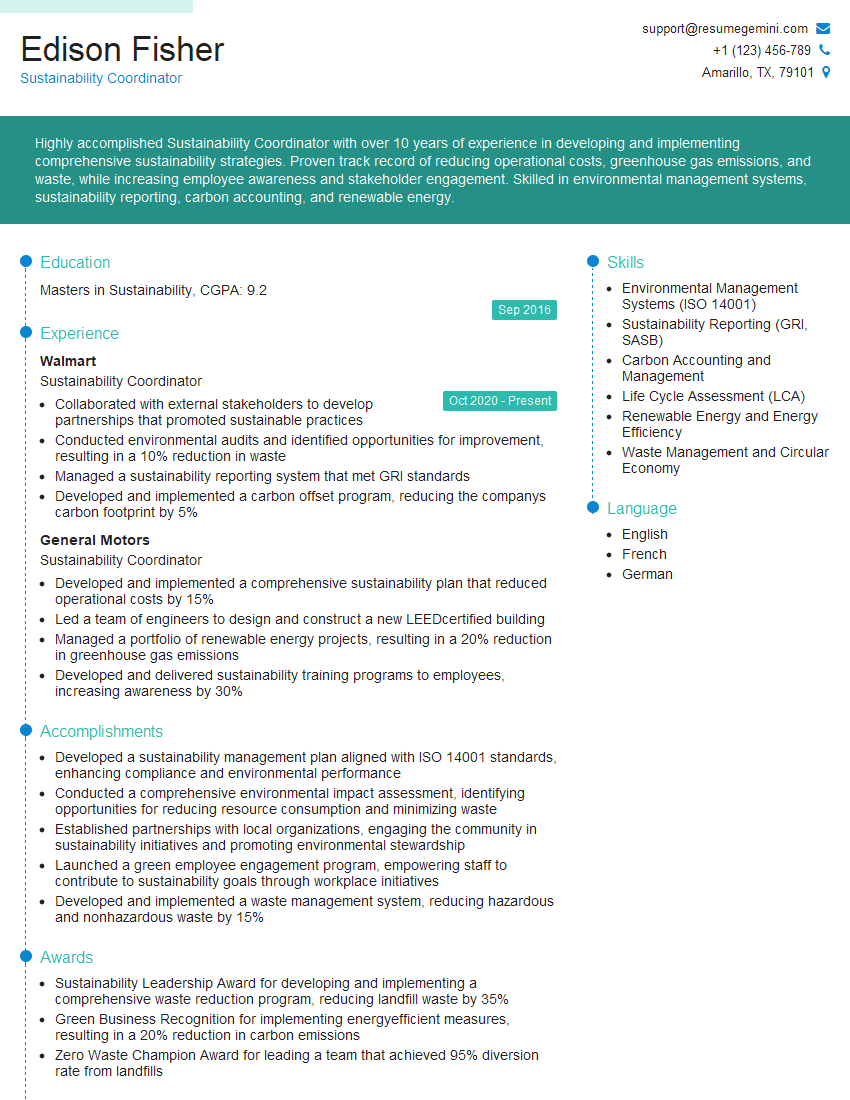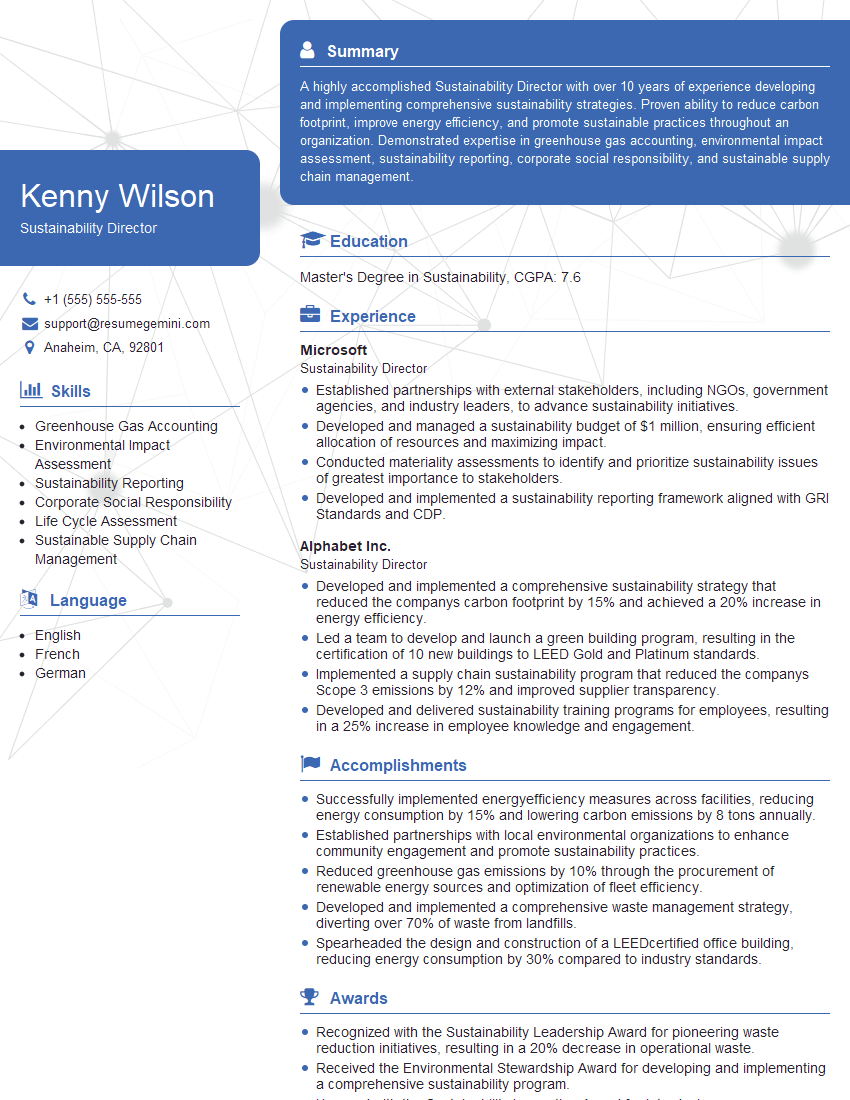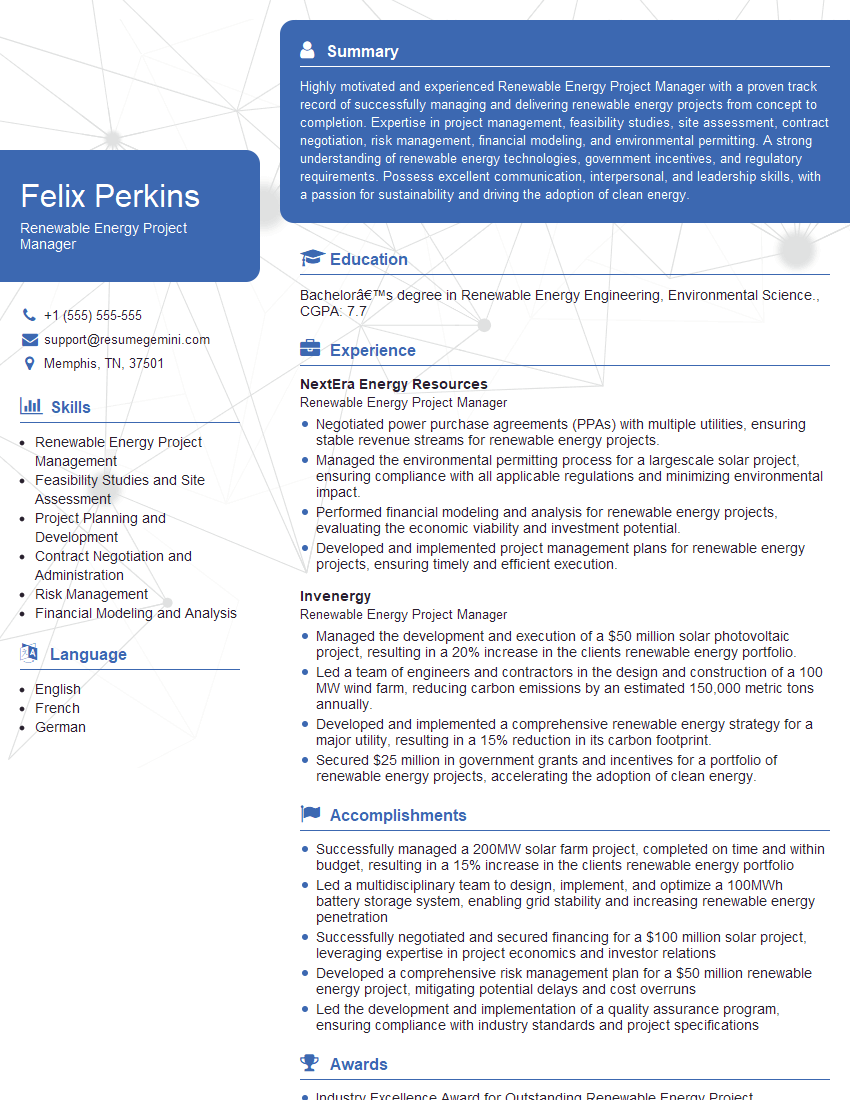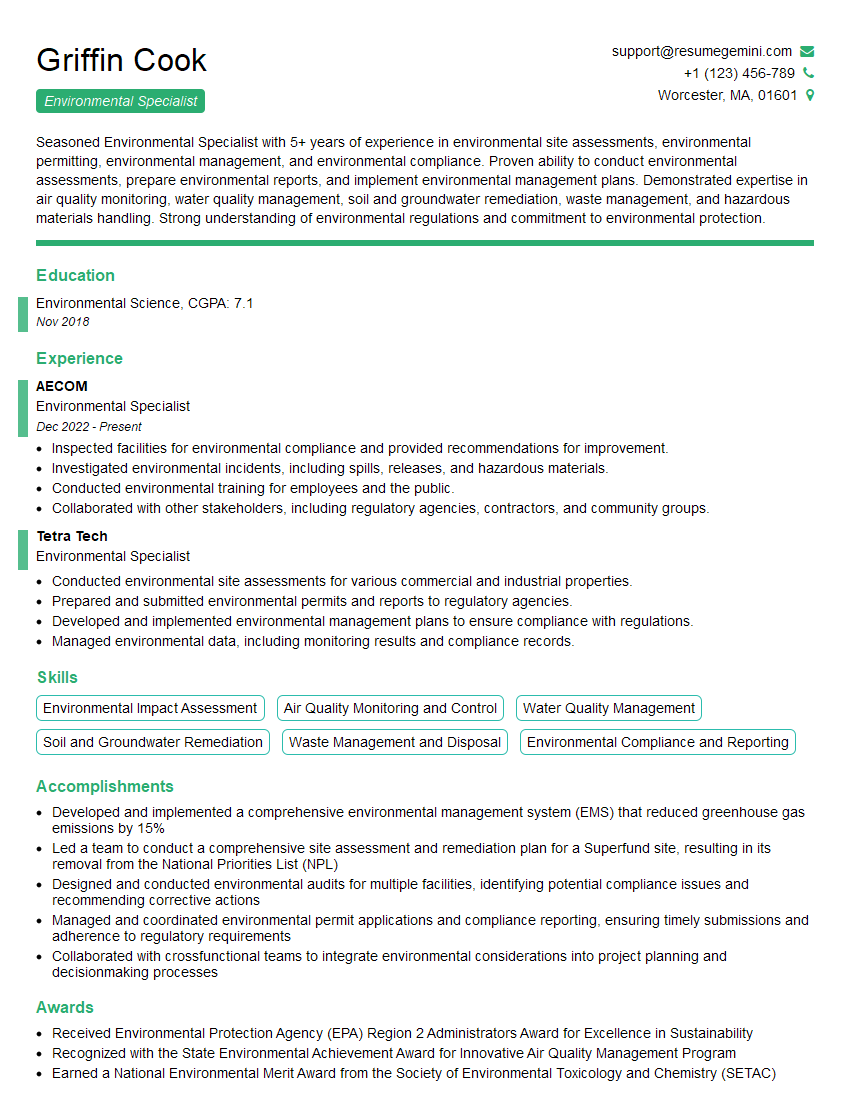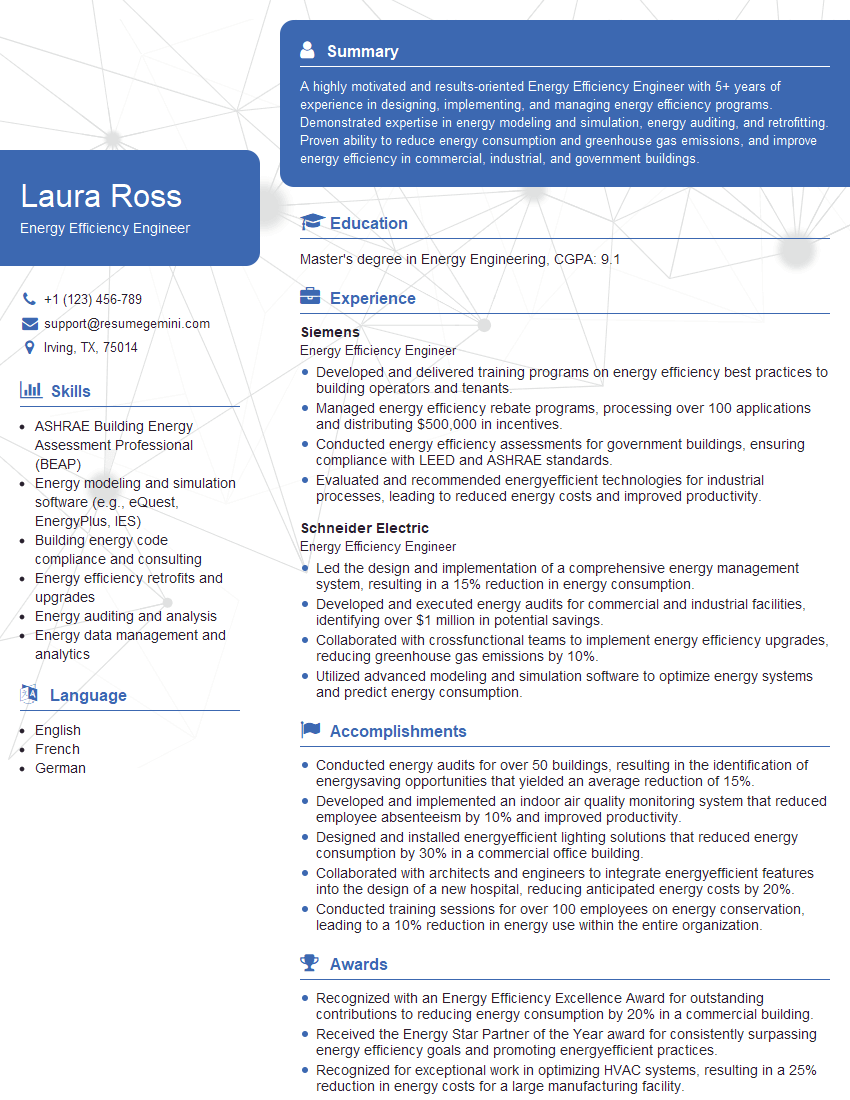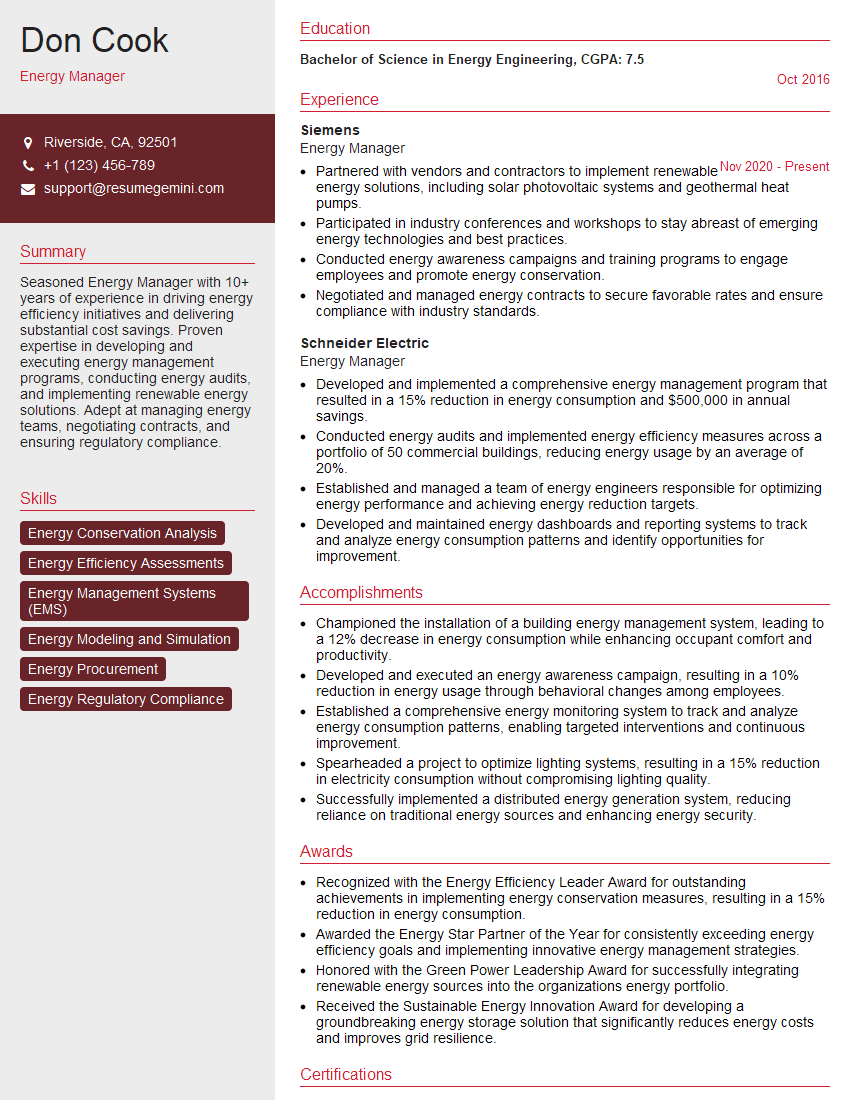Are you ready to stand out in your next interview? Understanding and preparing for Sustainability and Energy Efficiency Practices interview questions is a game-changer. In this blog, we’ve compiled key questions and expert advice to help you showcase your skills with confidence and precision. Let’s get started on your journey to acing the interview.
Questions Asked in Sustainability and Energy Efficiency Practices Interview
Q 1. Define LEED certification and its significance in green building.
LEED, or Leadership in Energy and Environmental Design, is a globally recognized green building certification program. It provides a framework for designing, constructing, and operating high-performance green buildings. Think of it as a gold standard for sustainable building practices. LEED certification isn’t just about ticking boxes; it’s about minimizing environmental impact throughout a building’s lifecycle, from selecting sustainable materials to optimizing energy and water efficiency. The significance lies in its comprehensive approach to sustainability, driving innovation and influencing the entire building industry towards a greener future.
LEED certification offers several benefits: reduced operational costs (lower energy and water bills), enhanced occupant health and productivity (better indoor air quality), increased property value, improved public image, and a competitive advantage in the marketplace. For example, a building achieving LEED Platinum certification demonstrates a remarkable commitment to sustainability, attracting tenants who value environmentally responsible spaces.
Q 2. Explain the concept of a carbon footprint and how it’s calculated.
A carbon footprint represents the total amount of greenhouse gases (GHGs) generated by our actions. It’s like a footprint, but instead of your foot on the ground, it’s the impact of your activities on the climate. This impact can stem from various sources, including burning fossil fuels for energy, transportation, deforestation, and industrial processes. Calculating a carbon footprint involves quantifying GHG emissions in terms of carbon dioxide equivalents (CO2e), a standardized unit that considers the global warming potential of different gases.
The calculation process typically involves a detailed inventory of all GHG sources related to a specific activity, product, or organization. This might involve measuring energy consumption, waste generation, transportation distances, and material sourcing. Organizations often use specialized software or consult with carbon accounting experts to perform accurate calculations. For instance, a company might calculate its carbon footprint to identify emission hotspots, set reduction targets, and develop a climate action plan. The result helps highlight areas for improvement and inform strategies for sustainability.
Q 3. Describe different renewable energy sources and their advantages/disadvantages.
Renewable energy sources are naturally replenished, unlike fossil fuels. Key examples include:
- Solar Power: Harnessing sunlight using photovoltaic cells or concentrated solar power (CSP). Advantages: Abundant, widely available, low operating costs. Disadvantages: Intermittency (sunlight availability varies), land use requirements, manufacturing impacts.
- Wind Power: Utilizing wind turbines to convert wind energy into electricity. Advantages: High energy output, relatively low environmental impact (excluding manufacturing and land use). Disadvantages: Intermittency (wind variability), visual impact on landscapes, noise pollution.
- Hydropower: Generating electricity from the flow of water, usually through dams. Advantages: Reliable energy source, long lifespan. Disadvantages: Significant environmental impacts (habitat disruption, greenhouse gas emissions from reservoirs), potential for displacement of communities.
- Geothermal Energy: Harnessing heat from the Earth’s interior. Advantages: Consistent energy source, relatively low emissions. Disadvantages: Geographic limitations (suitable locations are limited), potential for induced seismicity.
- Biomass Energy: Using organic matter (wood, crops) to produce energy. Advantages: Can be locally sourced, potential for carbon neutrality if sustainably managed. Disadvantages: Air pollution if poorly managed, land use competition with food production.
The choice of renewable energy source depends on various factors including geographic location, resource availability, environmental considerations, and economic feasibility.
Q 4. What are the key principles of sustainable development?
Sustainable development aims to meet the needs of the present without compromising the ability of future generations to meet their own needs. It’s about balancing economic growth, social equity, and environmental protection. The key principles include:
- Environmental Integrity: Protecting and restoring natural ecosystems, conserving resources, and minimizing pollution.
- Economic Viability: Ensuring economic growth that is sustainable in the long term, creating jobs, and promoting fair trade.
- Social Equity: Promoting social justice, reducing poverty and inequality, and ensuring access to basic needs for all.
- Intergenerational Equity: Considering the needs of future generations and ensuring that they have access to the resources they need.
- Precautionary Principle: Taking preventative measures to avoid potential environmental harm, even if the scientific understanding is incomplete.
Implementing these principles requires collaborative efforts from governments, businesses, and individuals. For instance, transitioning to a circular economy, which emphasizes reuse and recycling, reflects a commitment to both economic viability and environmental integrity.
Q 5. How do you perform an energy audit and interpret its results?
An energy audit is a systematic assessment of a building’s energy consumption to identify areas for improvement. It’s like a physical exam for your building, revealing its energy habits. The process involves several steps:
- Data Collection: Gathering information on energy usage (electricity, heating, cooling), building characteristics (size, insulation, windows), and equipment operation.
- On-site Inspection: Visually inspecting the building to identify potential energy losses, such as air leaks, inefficient equipment, or inadequate insulation.
- Energy Modeling: Using software to simulate energy flows and predict energy savings from potential improvements.
- Report Generation: Compiling the findings into a comprehensive report that outlines energy consumption patterns, identifies areas for improvement, and recommends cost-effective measures.
Interpreting the results involves analyzing energy consumption data, identifying energy waste sources, and evaluating the feasibility and cost-effectiveness of potential improvements. For example, the audit might reveal that inefficient lighting accounts for a significant portion of energy use, suggesting a switch to LED lighting as a primary improvement.
Q 6. Explain the difference between energy efficiency and energy conservation.
While both energy efficiency and energy conservation aim to reduce energy use, they differ in their approaches. Energy efficiency focuses on doing more with less energy, while energy conservation focuses on doing less to use less energy.
Energy Efficiency: Improves the efficiency of energy-using systems, achieving the same output with less energy input. For example, replacing an old inefficient furnace with a high-efficiency model. This is like getting the same amount of heat from less fuel.
Energy Conservation: Reduces energy consumption by modifying behavior or reducing the demand for energy services. For example, turning off lights when leaving a room or using public transportation instead of driving. This is about reducing the overall energy demand.
Both strategies are crucial for reducing energy consumption and achieving sustainability goals. An integrated approach, combining both efficiency and conservation measures, delivers the most significant impact.
Q 7. What are some common energy efficiency measures for buildings?
Common energy efficiency measures for buildings include:
- Improved Insulation: Adding insulation to walls, roofs, and floors to reduce heat loss in winter and heat gain in summer.
- High-Performance Windows: Installing windows with low-E coatings and gas fills to reduce heat transfer.
- Energy-Efficient Lighting: Switching to LED lighting, which consumes significantly less energy than traditional incandescent or fluorescent bulbs.
- High-Efficiency HVAC Systems: Installing energy-efficient heating, ventilation, and air conditioning systems.
- Building Envelope Improvements: Sealing air leaks in walls, windows, and doors to reduce energy loss.
- Smart Thermostats: Utilizing smart thermostats to optimize heating and cooling schedules based on occupancy patterns and weather conditions.
- Renewable Energy Integration: Installing solar panels or other renewable energy systems to generate on-site power.
- Water Heating Efficiency: Using tankless water heaters or improving insulation on existing water heaters.
Implementing these measures can significantly reduce a building’s energy consumption and operational costs, contributing to a more sustainable built environment. For example, a building retrofitted with energy-efficient measures might see a reduction in energy costs by 30% or more.
Q 8. Discuss various strategies for reducing a company’s carbon emissions.
Reducing a company’s carbon footprint requires a multi-pronged approach targeting emissions across the entire value chain. This involves a combination of operational changes, technological upgrades, and strategic decision-making.
- Energy Efficiency Improvements: This is the cornerstone. Investing in energy-efficient equipment (lighting, HVAC systems, motors), optimizing building design for natural light and insulation, and implementing smart energy management systems significantly reduces energy consumption and, consequently, carbon emissions. For example, switching to LED lighting can reduce energy consumption by up to 75% compared to traditional incandescent bulbs.
- Renewable Energy Sources: Transitioning to renewable energy sources like solar, wind, or geothermal power drastically decreases reliance on fossil fuels. This can involve installing on-site renewable energy generation or purchasing renewable energy credits (RECs) to offset emissions.
- Sustainable Transportation: Reducing emissions from transportation involves optimizing logistics, encouraging the use of public transport, cycling, or walking among employees, and transitioning to electric vehicle fleets or utilizing carbon-neutral fuel options.
- Waste Management: Implementing comprehensive waste reduction, recycling, and composting programs minimizes landfill waste, which produces significant methane emissions. Analyzing waste streams to identify opportunities for reuse or recycling is crucial.
- Sustainable Procurement: Choosing suppliers committed to sustainability ensures that the entire supply chain contributes to emission reduction. This involves considering the environmental impact of products and materials throughout their lifecycle.
- Carbon Offsetting: Investing in verified carbon offset projects, such as reforestation or renewable energy projects, compensates for unavoidable emissions. However, this should be considered a supplementary strategy, not a replacement for emission reduction efforts.
- Employee Engagement: Educating and engaging employees in sustainability initiatives is vital for success. Implementing company-wide sustainability awareness programs and promoting sustainable practices within the workplace fosters a culture of environmental responsibility.
A successful strategy involves a thorough carbon footprint assessment to identify emission hotspots and prioritize areas for intervention. Regular monitoring and reporting are essential to track progress and adapt strategies as needed.
Q 9. What is your experience with lifecycle assessment (LCA)?
Lifecycle Assessment (LCA) is a crucial tool for evaluating the environmental impacts of a product or service throughout its entire life cycle – from raw material extraction to disposal or recycling. My experience with LCA includes conducting numerous studies across diverse industries, utilizing both software tools and established methodologies like ISO 14040/44.
I’ve worked on LCAs for various products, including packaging materials, electronics, and building materials. This involved data collection, impact assessment, interpretation of results, and communicating findings to stakeholders. For example, in one project, we used LCA to compare the environmental performance of different packaging options for a food product, considering factors like energy use, transportation emissions, and waste generation. The results informed the company’s decision to switch to a more sustainable packaging material, leading to a significant reduction in their environmental footprint.
I am proficient in using various LCA software packages and have experience in handling complex data sets and uncertainty analysis. My understanding extends beyond simply conducting the assessment; I can also interpret results, identify opportunities for improvement, and communicate the findings effectively to technical and non-technical audiences.
Q 10. How familiar are you with ISO 14001 or other environmental management systems?
I’m very familiar with ISO 14001, the internationally recognized standard for Environmental Management Systems (EMS). I’ve been involved in multiple projects where we implemented and audited ISO 14001, leading to improved environmental performance and reduced risks. Understanding ISO 14001 goes beyond simply meeting the requirements; it’s about building a robust system for continual improvement.
My experience encompasses all aspects of ISO 14001 implementation, including:
- Gap analysis: Assessing the organization’s current environmental performance against the ISO 14001 requirements.
- Policy development: Creating an environmental policy that sets clear objectives and targets.
- EMS implementation: Establishing procedures and processes for environmental management.
- Internal audits: Regularly assessing the effectiveness of the EMS.
- Management review: Reviewing the EMS’s performance and making necessary improvements.
Beyond ISO 14001, I have experience with other environmental management systems, and I understand the principles and benefits of using standardized frameworks to improve environmental performance. I’m also familiar with various industry-specific environmental standards and regulations.
Q 11. Describe your experience with sustainability reporting and frameworks (e.g., GRI).
I have extensive experience with sustainability reporting, primarily utilizing the Global Reporting Initiative (GRI) Standards. I’ve prepared numerous sustainability reports for organizations of varying sizes and sectors. This involves collecting data, analyzing performance against established key performance indicators (KPIs), and communicating results transparently and effectively to stakeholders.
My experience encompasses all aspects of the reporting process, including:
- Materiality assessment: Identifying the most significant environmental and social issues relevant to the organization.
- Data collection and analysis: Gathering and analyzing data on environmental and social performance.
- Report writing and design: Creating a clear, concise, and engaging sustainability report.
- Stakeholder engagement: Engaging with stakeholders to ensure the report reflects their concerns and expectations.
- Assurance: Obtaining independent verification of the data and claims made in the report (where applicable).
I’m also familiar with other sustainability reporting frameworks, such as the Sustainability Accounting Standards Board (SASB) and the Task Force on Climate-related Financial Disclosures (TCFD), and can adapt my approach to meet specific reporting requirements.
Q 12. How would you implement a sustainability program in a new organization?
Implementing a sustainability program in a new organization requires a structured, phased approach. It’s not a one-size-fits-all solution; it must align with the organization’s specific context, values, and goals.
- Stakeholder Engagement and Assessment: Begin by engaging key stakeholders (leadership, employees, customers, and community) to understand their perspectives, priorities, and concerns regarding sustainability. Conduct a thorough materiality assessment to determine the most significant environmental and social issues relevant to the organization.
- Baseline Assessment and Goal Setting: Conduct a baseline assessment of the organization’s current environmental and social performance. This forms the basis for setting measurable, achievable, relevant, and time-bound (SMART) sustainability goals. The goals should be ambitious yet realistic, aligning with broader sustainability targets (e.g., Science Based Targets).
- Program Design and Implementation: Based on the assessment and goals, develop a detailed sustainability program with specific initiatives and action plans. This might include energy efficiency projects, waste reduction programs, sustainable procurement policies, and employee engagement initiatives.
- Resource Allocation and Monitoring: Allocate sufficient resources (budget, personnel, technology) to support the program’s implementation. Establish a system for monitoring progress towards goals, tracking key performance indicators (KPIs), and regularly reporting on performance.
- Communication and Reporting: Effectively communicate the program’s goals, progress, and successes to internal and external stakeholders. Prepare regular sustainability reports, aligning with relevant reporting frameworks like GRI.
- Continuous Improvement: Regularly review and update the sustainability program to ensure its effectiveness and relevance. Feedback mechanisms are crucial for continuous improvement and adaptation to evolving needs and priorities.
A crucial aspect is securing buy-in from top management, as their support and commitment are essential for a successful sustainability program.
Q 13. What are the key challenges in implementing sustainable practices?
Implementing sustainable practices presents various challenges:
- Financial constraints: Upfront investments in energy efficiency upgrades, renewable energy technologies, or sustainable materials can be substantial, requiring careful financial planning and potentially external funding.
- Lack of awareness and engagement: Securing buy-in from all stakeholders – from leadership to employees – is crucial. Lack of awareness about sustainability issues or insufficient engagement can hinder progress.
- Technological limitations: Finding and implementing suitable sustainable technologies can be challenging, especially for niche applications or in specific contexts. The technology may be expensive or lack sufficient scalability.
- Data availability and accuracy: Collecting accurate and reliable data on environmental performance can be challenging, particularly for complex organizations or supply chains.
- Regulatory uncertainty: Changes in environmental regulations and policies can impact the feasibility and cost-effectiveness of sustainability initiatives.
- Measuring and demonstrating impact: Accurately quantifying the environmental benefits of sustainability actions and demonstrating their return on investment (ROI) can be difficult.
- Supply chain complexities: Managing and improving the sustainability performance of an organization’s entire supply chain is a complex task, requiring collaborative efforts and strong supplier relationships.
Addressing these challenges requires a well-defined strategy, strong leadership, stakeholder engagement, and commitment to continuous improvement.
Q 14. Explain different methods for measuring energy consumption in a building.
Measuring energy consumption in a building requires a multifaceted approach combining various methods for comprehensive data collection and analysis.
- Submetering: Installing submeters on individual circuits or equipment allows precise measurement of energy consumption by specific systems (lighting, HVAC, etc.). This provides detailed insights into energy usage patterns and helps identify energy-intensive areas.
- Building Management Systems (BMS): BMS collect data from various building sensors and systems (HVAC, lighting, etc.), providing real-time energy consumption information. Sophisticated BMS can also optimize energy usage based on occupancy, weather conditions, and other factors.
- Smart Meters: Smart meters record energy usage at regular intervals, allowing for detailed analysis of consumption trends over time. This data can be remotely accessed and used for energy optimization and billing purposes.
- Energy Audits: Professional energy audits employ various techniques, including visual inspections, data analysis, and specialized equipment, to identify energy waste and opportunities for improvement. Energy audits often provide recommendations for retrofitting and improving building efficiency.
- Utility Bills: While not as precise as submetering, utility bills provide an overall measure of building energy consumption. Analyzing trends in utility bills over time can highlight variations and potential areas for investigation.
The choice of method depends on the building’s size, complexity, and the specific goals of the measurement process. Often, a combination of methods is used to provide a comprehensive picture of energy consumption. The collected data should be analyzed to identify areas for energy savings and to track the effectiveness of energy-efficiency improvements.
Q 15. How can building design contribute to energy efficiency?
Building design plays a crucial role in energy efficiency. It’s about creating structures that minimize energy consumption for heating, cooling, and lighting. This is achieved through a holistic approach considering factors from the initial site selection to material choices and building orientation.
Passive design strategies: These leverage natural resources like sunlight and wind to reduce reliance on mechanical systems. Examples include maximizing south-facing windows for solar gain in colder climates, using overhangs to shade windows in summer, and strategically positioning buildings to take advantage of prevailing breezes for natural ventilation.
Building envelope optimization: A well-insulated and airtight building envelope (walls, roof, windows) is paramount. High-performance windows with low U-values (indicating low heat transfer) and proper insulation significantly reduce energy loss. Think of it like wrapping your house in a cozy blanket to keep it warm in winter and cool in summer.
Efficient HVAC systems: Selecting appropriately sized and high-efficiency heating, ventilation, and air conditioning (HVAC) systems is critical. Variable refrigerant flow (VRF) systems, for example, offer precise temperature control and energy savings compared to traditional systems.
Daylighting and artificial lighting strategies: Optimizing natural light reduces the need for artificial lighting. Strategic placement of windows and the use of light shelves can maximize daylight penetration. Efficient LED lighting with occupancy sensors further reduces energy use.
For example, a building designed with passive solar heating and high-performance windows might require significantly less energy for space heating compared to a conventionally designed building. The overall reduction in energy consumption directly translates to lower operating costs and reduced carbon footprint.
Career Expert Tips:
- Ace those interviews! Prepare effectively by reviewing the Top 50 Most Common Interview Questions on ResumeGemini.
- Navigate your job search with confidence! Explore a wide range of Career Tips on ResumeGemini. Learn about common challenges and recommendations to overcome them.
- Craft the perfect resume! Master the Art of Resume Writing with ResumeGemini’s guide. Showcase your unique qualifications and achievements effectively.
- Don’t miss out on holiday savings! Build your dream resume with ResumeGemini’s ATS optimized templates.
Q 16. What are your thoughts on the role of technology in promoting sustainability?
Technology is an indispensable tool in promoting sustainability. It provides us with the means to monitor, measure, and optimize energy consumption, as well as develop innovative solutions for cleaner energy production and resource management.
Smart building technologies: Building Management Systems (BMS) provide real-time data on energy use, allowing for efficient operation and early detection of anomalies. Smart meters provide granular energy usage information, empowering building occupants to make conscious choices.
Renewable energy technologies: Solar photovoltaic (PV) systems, wind turbines, and geothermal energy systems offer clean alternatives to fossil fuels. Advances in battery storage technology are making renewable energy sources increasingly reliable.
Energy modeling software: Tools like EnergyPlus and TRNSYS allow designers and engineers to simulate building performance, optimize designs, and predict energy consumption before construction, enabling informed decision-making and potential cost savings.
Data analytics and AI: Analyzing energy usage data with AI can identify patterns and predict future consumption, allowing for proactive adjustments and optimization strategies.
Imagine a city where buildings are equipped with smart sensors, generating their own energy from renewable sources and optimizing consumption in real-time. This is no longer a futuristic vision, but a tangible goal made possible by technology.
Q 17. Describe your experience with different energy modeling software.
I have extensive experience using various energy modeling software, including EnergyPlus, TRNSYS, and IES VE. EnergyPlus is a powerful open-source tool particularly effective for detailed building energy simulations. TRNSYS excels in simulating complex systems involving renewable energy technologies. IES VE offers a more user-friendly interface and is suitable for early-stage design explorations. My experience includes building detailed models for various building types, from residential homes to large commercial structures, using these tools to analyze energy performance, evaluate different design options, and optimize energy efficiency measures.
For instance, in a recent project involving a high-rise office building, I used EnergyPlus to compare the energy performance of different façade designs – one with conventional glazing and another with high-performance windows. The simulation showed a substantial reduction in heating and cooling loads with the high-performance glazing, leading to a significant decrease in the building’s energy consumption and operational costs. This directly impacted the project’s sustainability goals and ensured a cost-effective solution.
Q 18. What are some common barriers to energy efficiency adoption, and how can they be overcome?
Several barriers hinder widespread energy efficiency adoption. These include:
High upfront costs: Implementing energy-efficient measures often involves significant initial investments, which can be a deterrent for building owners and developers.
Lack of awareness and knowledge: Many stakeholders lack awareness of the available technologies and their benefits. This includes understanding the long-term cost savings associated with energy efficiency upgrades.
Regulatory barriers: Outdated building codes and a lack of supportive policies can hinder the adoption of more stringent energy efficiency standards.
Financing challenges: Securing funding for energy efficiency projects can be difficult, especially for smaller businesses or individuals.
To overcome these barriers, we need a multi-pronged approach:
Incentives and rebates: Government incentives, tax credits, and rebates can make energy efficiency upgrades more financially attractive.
Public awareness campaigns: Educating stakeholders about the benefits of energy efficiency can drive demand and encourage adoption.
Streamlined permitting processes: Simplifying the permitting process can reduce delays and bureaucratic hurdles.
Access to financing: Developing innovative financing mechanisms, such as green bonds or performance-based financing, can improve access to capital for energy efficiency projects.
For example, a successful program in Germany offers substantial subsidies for homeowners undertaking building renovations that enhance energy efficiency, making such upgrades financially viable even for individuals with limited budgets.
Q 19. How do you stay updated on the latest developments in sustainability and energy efficiency?
Staying current in the dynamic fields of sustainability and energy efficiency is crucial. I employ a multifaceted approach:
Professional organizations: I am an active member of organizations such as ASHRAE (American Society of Heating, Refrigerating and Air-Conditioning Engineers) and USGBC (U.S. Green Building Council), which provide access to cutting-edge research, publications, and networking opportunities.
Conferences and workshops: Attending industry conferences and workshops allows me to learn about the latest developments and network with leading experts.
Academic journals and publications: I regularly read peer-reviewed journals and industry publications to stay informed about research breakthroughs and technological advancements.
Online resources and databases: I utilize online databases such as Scopus and Web of Science to access research papers and technical reports. I also follow leading experts and institutions on social media platforms.
This continuous learning ensures I am equipped with the latest knowledge and best practices to deliver effective and sustainable solutions.
Q 20. Explain the concept of circular economy and its relevance to sustainability.
The circular economy is an economic model aimed at minimizing waste and maximizing resource utilization. It contrasts with the traditional linear “take-make-dispose” model by emphasizing reuse, repair, refurbishment, remanufacturing, and recycling.
Its relevance to sustainability is profound. By closing the loop on resource flows, it reduces our reliance on virgin materials, minimizes pollution, conserves energy, and creates more resilient and sustainable economic systems.
Waste reduction: The circular economy prioritizes reducing waste at the source through design for disassembly, product longevity, and improved material selection.
Resource recovery: It promotes the recovery of valuable materials from waste streams through recycling, composting, and other methods.
Renewable energy: Integrating renewable energy sources into manufacturing processes reduces the carbon footprint of production.
For example, a company might design a product with easily replaceable parts, extending its lifespan and reducing waste. Or a manufacturer could implement a take-back program, allowing them to recycle materials from end-of-life products, closing the loop and reducing reliance on virgin resources. These practices are key to achieving environmental sustainability and building a more resilient economy.
Q 21. What are some examples of sustainable procurement practices?
Sustainable procurement practices prioritize environmentally and socially responsible sourcing of goods and services. This involves considering the entire lifecycle of a product, from material extraction to disposal, and selecting options that minimize negative impacts.
Prioritizing recycled content: Specifying materials with high recycled content reduces the demand for virgin materials and minimizes waste.
Using sustainable materials: Opting for sustainably harvested timber, recycled steel, or bio-based materials reduces the environmental footprint of construction.
Energy-efficient products: Selecting energy-efficient equipment, appliances, and lighting reduces ongoing energy consumption.
Considering lifecycle costs: Evaluating the total cost of ownership, including maintenance and disposal costs, helps to make informed decisions that minimize overall environmental impact.
Supporting local suppliers: Sourcing materials and services locally reduces transportation emissions and supports local economies.
Fair labor practices: Ensuring that products are sourced ethically, respecting workers’ rights and fair wages, contributes to social sustainability.
For instance, a construction project might specify the use of recycled steel for structural elements, reducing the demand for newly produced steel and lowering carbon emissions. Likewise, choosing locally sourced lumber reduces transportation impacts and supports local forestry practices. Adopting these practices is crucial for making supply chains environmentally and socially responsible.
Q 22. Describe your experience with waste management and recycling programs.
My experience with waste management and recycling programs spans diverse sectors, from municipal solid waste management to industrial waste reduction. I’ve been involved in designing and implementing comprehensive waste reduction strategies, including waste audits to identify waste streams, developing tailored recycling programs focusing on material recovery and diversion from landfills, and implementing composting initiatives.
For example, in a previous role, I led a project to implement a zero-waste-to-landfill program at a large manufacturing facility. This involved educating employees about proper waste sorting, negotiating contracts with recycling vendors, and tracking waste diversion rates. We saw a 70% reduction in landfill waste within two years. Another project focused on optimizing the recycling of e-waste, which required a nuanced approach involving careful sorting of hazardous materials and secure disposal practices to meet regulatory compliance.
My approach always considers the life cycle assessment of materials, aiming for maximum reuse, repurposing, and recycling. I understand the importance of upstream waste prevention, focusing on minimizing waste generation at the source rather than solely relying on downstream solutions.
Q 23. How do you prioritize sustainability initiatives within a budget constraint?
Prioritizing sustainability initiatives under budget constraints requires a strategic and data-driven approach. I begin by conducting a thorough cost-benefit analysis for each proposed initiative, considering both short-term and long-term financial impacts. This includes identifying potential energy savings, reduced operational costs, and improved resource efficiency.
I then prioritize projects based on their return on investment (ROI) and potential for significant environmental impact. High-ROI projects with quick payback periods are often prioritized. For example, implementing energy-efficient lighting can yield significant savings in the short term, providing a strong return on investment.
Furthermore, I explore opportunities for securing external funding through grants, subsidies, or carbon offset programs to supplement the budget. Phased implementation is another useful tactic; breaking down large projects into smaller, more manageable phases allows for incremental progress while aligning with budget limitations. Finally, effective communication with stakeholders is vital to ensure buy-in and support for the chosen initiatives.
Q 24. What are your skills in data analysis relevant to sustainability efforts?
My data analysis skills are crucial for effective sustainability efforts. I’m proficient in using various software tools to collect, clean, analyze, and visualize environmental data. This includes using software like Excel, R, and specialized environmental management systems. I can analyze energy consumption patterns, waste generation data, carbon footprints, and water usage.
For example, I’ve used statistical analysis to identify energy efficiency improvement opportunities in buildings, demonstrating correlations between building characteristics and energy usage. I’ve also employed data visualization techniques to present complex sustainability data to non-technical audiences in a clear and engaging way. I’m adept at using data to track progress towards sustainability goals and identify areas for improvement, leading to evidence-based decision-making.
My skills also encompass lifecycle assessments (LCAs) – using data to evaluate the environmental impacts of products and services across their entire lifespan, from raw material extraction to end-of-life disposal. This allows for informed choices regarding sustainable material selection and process optimization.
Q 25. How would you approach stakeholder engagement in a sustainability project?
Stakeholder engagement is paramount to the success of any sustainability project. I employ a multi-faceted approach, starting with identifying all relevant stakeholders—this includes employees, management, customers, suppliers, regulators, and the community.
I then use diverse communication channels – workshops, surveys, focus groups, and individual meetings – to understand their perspectives, concerns, and expectations. Transparent and open communication is essential; I ensure regular updates and feedback mechanisms to build trust and foster collaboration.
For example, in a community engagement project focused on renewable energy development, I organized public forums and workshops to discuss project plans, address concerns regarding environmental impacts, and solicit community input. This collaborative approach resulted in a project design that met both community needs and sustainability objectives.
Addressing potential conflicts and resistance is equally important. This requires skillful negotiation, conflict resolution techniques, and a genuine commitment to finding mutually beneficial solutions. Building consensus and a shared vision are critical to long-term success.
Q 26. What are your experience with different renewable energy project development phases?
My experience encompasses all phases of renewable energy project development, from initial feasibility studies and site assessment through to construction, commissioning, and ongoing operations and maintenance.
In the feasibility phase, I analyze resource potential (e.g., solar irradiance, wind speed), assess grid connection possibilities, perform financial modeling to evaluate project viability, and conduct environmental impact assessments (EIAs). This involves working with engineers, environmental consultants, and financial analysts.
During the design and engineering phase, I collaborate with engineers to optimize project design for maximum efficiency and minimal environmental impact, considering factors like land use, wildlife impacts, and aesthetic considerations. Construction oversight involves monitoring progress, ensuring adherence to environmental regulations, and managing construction waste.
Finally, post-construction, I oversee operations and maintenance, ensuring the project performs optimally, complies with regulations, and provides reliable energy generation over its lifespan. I have experience with solar PV, wind, hydro, and biomass projects.
Q 27. Describe your experience in evaluating the financial viability of energy efficiency projects.
Evaluating the financial viability of energy efficiency projects requires a comprehensive approach. I use a range of financial tools and methodologies to assess project costs, benefits, and risks.
This includes calculating the simple payback period (the time it takes for cost savings to cover the initial investment), net present value (NPV), internal rate of return (IRR), and life-cycle cost analysis (LCCA). I also consider factors such as energy price volatility, potential rebates and incentives, and the project’s lifespan.
For example, when evaluating the feasibility of replacing outdated HVAC systems with high-efficiency units, I would consider the initial investment cost, the anticipated energy savings over the system’s lifespan, potential maintenance cost reductions, and any available government incentives. I would then use discounted cash flow analysis to determine the project’s NPV and IRR, providing a clear picture of its financial attractiveness. Sensitivity analysis is also crucial to assess how changes in various factors might impact project viability.
Q 28. How do you communicate complex sustainability concepts to diverse audiences?
Communicating complex sustainability concepts to diverse audiences requires tailoring the message to the audience’s background and level of understanding. I avoid technical jargon whenever possible, using clear, concise language and relatable analogies.
For example, when explaining carbon footprints to a group of business leaders, I might focus on the financial implications of carbon emissions and the potential cost savings from adopting sustainability measures. With a community group, I would emphasize the environmental and social benefits of sustainable practices, linking them to local environmental issues and community well-being.
I use various communication tools, including presentations, infographics, videos, and interactive workshops to enhance engagement and understanding. Visual aids, case studies, and real-world examples make abstract concepts more tangible and relatable. Active listening and feedback mechanisms are essential to ensure the message is received and understood effectively.
Key Topics to Learn for Sustainability and Energy Efficiency Practices Interview
- Lifecycle Assessment (LCA): Understanding the environmental impact of products and services from cradle to grave. This includes analyzing resource extraction, manufacturing, use, and disposal phases.
- Energy Audits and Modeling: Conducting energy audits to identify areas for improvement and using energy modeling software to simulate different scenarios and predict energy savings.
- Renewable Energy Technologies: Familiarizing yourself with various renewable energy sources (solar, wind, hydro, geothermal, biomass) and their applications, including their advantages and limitations.
- Building Energy Codes and Standards: Knowledge of relevant building codes and standards (e.g., LEED, BREEAM) and their implementation in achieving energy efficiency.
- Sustainable Materials and Construction: Understanding the environmental impact of building materials and exploring sustainable alternatives, such as recycled content and sustainably harvested timber.
- Waste Management and Circular Economy Principles: Strategies for minimizing waste generation, promoting recycling and reuse, and implementing circular economy principles in various sectors.
- Carbon Accounting and Reporting: Measuring and reporting greenhouse gas emissions, understanding carbon footprints, and developing strategies for carbon reduction.
- Policy and Regulations: Familiarity with relevant environmental regulations, policies, and incentives related to sustainability and energy efficiency.
- Data Analysis and Interpretation: Analyzing energy consumption data, identifying trends, and drawing conclusions to inform decision-making.
- Problem-Solving and Innovation: Demonstrating the ability to identify and solve sustainability challenges creatively and develop innovative solutions.
Next Steps
Mastering Sustainability and Energy Efficiency Practices is crucial for a thriving career in a rapidly evolving green economy. These skills are highly sought after, offering diverse opportunities and contributing to a positive environmental impact. To maximize your job prospects, create a compelling and ATS-friendly resume that showcases your expertise. ResumeGemini is a trusted resource that can help you build a professional resume that highlights your unique skills and experience. Examples of resumes tailored to Sustainability and Energy Efficiency Practices are available to guide you. Invest time in crafting a strong resume – it’s your first impression with potential employers.
Explore more articles
Users Rating of Our Blogs
Share Your Experience
We value your feedback! Please rate our content and share your thoughts (optional).
What Readers Say About Our Blog
Interesting Article, I liked the depth of knowledge you’ve shared.
Helpful, thanks for sharing.
Hi, I represent a social media marketing agency and liked your blog
Hi, I represent an SEO company that specialises in getting you AI citations and higher rankings on Google. I’d like to offer you a 100% free SEO audit for your website. Would you be interested?
